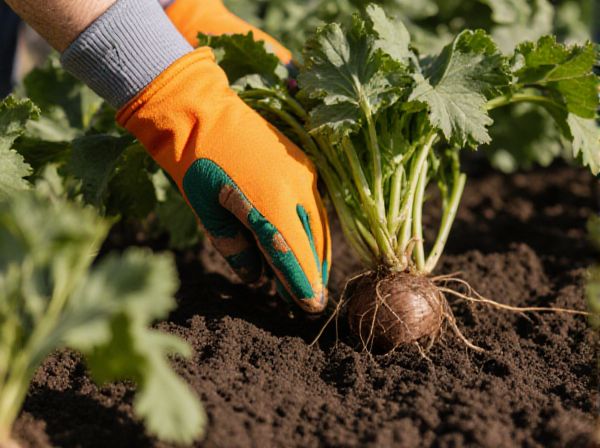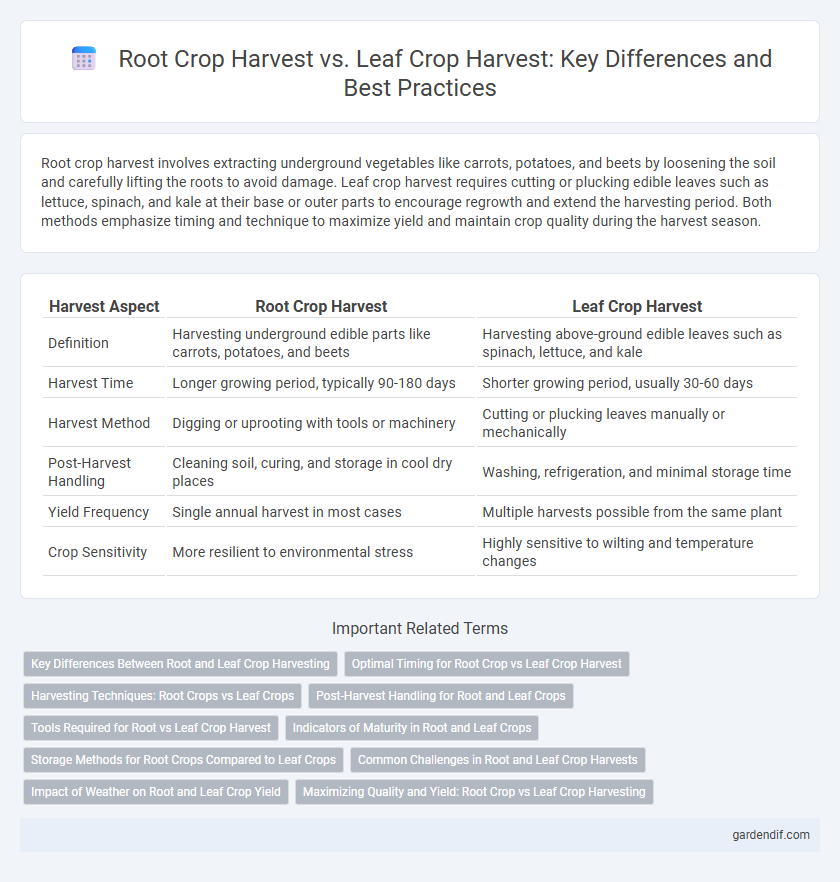
Root Crop Harvest vs Leaf Crop Harvest Illustration
Root crop harvest involves extracting underground vegetables like carrots, potatoes, and beets by loosening the soil and carefully lifting the roots to avoid damage. Leaf crop harvest requires cutting or plucking edible leaves such as lettuce, spinach, and kale at their base or outer parts to encourage regrowth and extend the harvesting period. Both methods emphasize timing and technique to maximize yield and maintain crop quality during the harvest season.
Table of Comparison
| Harvest Aspect | Root Crop Harvest | Leaf Crop Harvest |
|---|---|---|
| Definition | Harvesting underground edible parts like carrots, potatoes, and beets | Harvesting above-ground edible leaves such as spinach, lettuce, and kale |
| Harvest Time | Longer growing period, typically 90-180 days | Shorter growing period, usually 30-60 days |
| Harvest Method | Digging or uprooting with tools or machinery | Cutting or plucking leaves manually or mechanically |
| Post-Harvest Handling | Cleaning soil, curing, and storage in cool dry places | Washing, refrigeration, and minimal storage time |
| Yield Frequency | Single annual harvest in most cases | Multiple harvests possible from the same plant |
| Crop Sensitivity | More resilient to environmental stress | Highly sensitive to wilting and temperature changes |
Key Differences Between Root and Leaf Crop Harvesting
Root crop harvesting involves extracting underground edible parts such as potatoes, carrots, and beets, requiring specialized tools like digging forks or mechanical harvesters to minimize damage. Leaf crop harvesting, targeting above-ground parts like lettuce, spinach, and kale, typically uses hand-picking or cutting tools to maintain leaf integrity and prevent bruising. Key differences include harvest timing, with root crops allowing longer in-ground maturation, while leaf crops demand frequent harvesting to ensure freshness and continuous foliage production.
Optimal Timing for Root Crop vs Leaf Crop Harvest
Optimal timing for root crop harvest depends on the full maturity of underground parts, typically indicated by the size and firmness of roots like carrots, beets, and radishes, ensuring maximum nutrient accumulation and storability. Leaf crop harvest prioritizes harvesting at the peak of leaf tenderness and nutrient content, often before flowering or bolting stages in crops such as lettuce, spinach, and kale to maintain optimal freshness and flavor. Monitoring specific growth stages and environmental conditions enables precise timing for each crop type, maximizing yield quality and post-harvest longevity.
Harvesting Techniques: Root Crops vs Leaf Crops
Harvesting root crops requires careful soil loosening and gentle lifting to avoid damaging underground tubers such as potatoes and carrots, often utilizing tools like digging forks or mechanical harvesters for efficient extraction. Leaf crop harvesting, including crops like spinach and lettuce, involves precise cutting of foliage to ensure regrowth and maintain plant health, typically using sharp knives or specialized cutting machinery. Timing and technique differences are crucial; root crops need to be fully matured underground, whereas leaf crops are harvested at optimal leaf size to preserve quality and extend shelf life.
Post-Harvest Handling for Root and Leaf Crops
Root crop harvest requires careful post-harvest handling to minimize damage, including gentle lifting, cleaning, and curing to extend shelf life and reduce spoilage. Leaf crop harvest demands rapid cooling, proper moisture control, and delicate packaging to preserve freshness and prevent wilting or microbial growth. Proper sorting and storage conditions tailored to each crop type are essential to maintain quality and market value.
Tools Required for Root vs Leaf Crop Harvest
Root crop harvest requires durable digging tools such as spades, hoes, and specialized root lifters to extract tubers like potatoes and carrots without damage. Leaf crop harvest relies on sharp cutting instruments like sickles, pruning shears, or knives to efficiently gather leafy vegetables such as lettuce, spinach, and kale while preserving plant health. Proper selection of tools enhances harvest efficiency and reduces crop loss in both root and leaf crops.
Indicators of Maturity in Root and Leaf Crops
Indicators of maturity in root crops include the size and color of the roots, firmness, and the development of secondary roots, which signal readiness for harvest. Leaf crops show maturity through factors such as full leaf expansion, vibrant coloration, and the absence of bitterness or toughening in the leaf texture. Monitoring these attributes helps optimize harvest timing to ensure maximum yield quality and nutritional value.
Storage Methods for Root Crops Compared to Leaf Crops
Root crops such as carrots, potatoes, and beets require storage in cool, dark, and humid environments to prevent dehydration and spoilage, often using methods like sand or sawdust packing and controlled atmosphere storage. Leaf crops such as lettuce, spinach, and kale need refrigeration at high humidity with good air circulation to maintain freshness, typically stored at temperatures just above freezing. The dense structure and lower respiration rate of root crops allow for longer storage periods compared to the highly perishable, moisture-rich leaf crops that require rapid consumption or processing.
Common Challenges in Root and Leaf Crop Harvests
Root crop harvests commonly face challenges such as soil compaction, which can damage tubers like potatoes and carrots, and uneven maturity leading to inconsistent crop quality. Leaf crop harvests often struggle with rapid spoilage post-harvest due to high moisture content, as seen in lettuce and spinach, and vulnerability to physical damage during mechanical harvesting. Both root and leaf crops require precise timing and careful handling to minimize losses and maintain product quality during the harvesting process.
Impact of Weather on Root and Leaf Crop Yield
Weather significantly affects root crop harvests by influencing soil moisture levels and temperature, which directly impact root development and size, essential for crops like carrots and potatoes. For leaf crops such as lettuce and spinach, weather conditions like humidity and sunlight intensity alter leaf growth rates and quality, often determining overall yield and marketability. Extreme weather events, including droughts or excessive rainfall, can cause root crops to become undersized or rot, while leafy crops may experience bolting or leaf damage, leading to reduced harvest volumes.
Maximizing Quality and Yield: Root Crop vs Leaf Crop Harvesting
Maximizing quality and yield in root crop harvesting involves careful timing to ensure optimal starch accumulation and firmness, with gentle handling to prevent bruising or damage to tubers like potatoes and carrots. In leaf crop harvesting, such as spinach and lettuce, frequent harvesting at the right maturity stage promotes tender texture and nutrient retention while preventing premature bolting or leaf yellowing. Employing crop-specific harvesting techniques and post-harvest handling significantly enhances marketable yield and maintains crop quality.
Root Crop Harvest vs Leaf Crop Harvest Infographic

 gardendif.com
gardendif.com